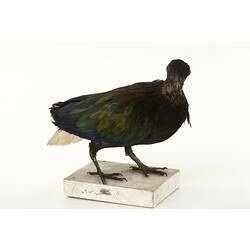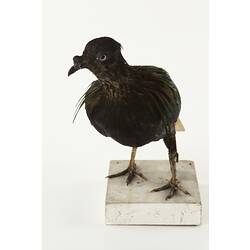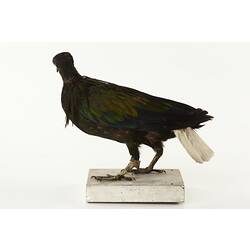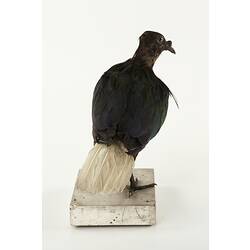Summary
Nicobar Pigeons are a large pigeon species with a grey head and distinctive white tail feathers. They naturally occur on small islands from the Andaman and Nicobar Islands, from which they take their name, east through southeast Asia to the Solomon Islands.
This adult female specimen was donated to the Museum in 1890 by the Zoological and Acclimatisation Society of Victoria which managed the Melbourne Zoological Gardens, now commonly known as Melbourne Zoo, where it was probably raised. This taxidermy mount has been reconstructed with the distinctive white eye of the females rather than the brown of males.
Nicobar Pigeons are the closest living relative of the extinct Dodo. Like the Dodo they are vulnerable to the destruction of their habitat, largely by logging or construction and to hunting. They are also vulnerable to predators, such as cats or rats, introduced to their islands and as they nest and breed in large colonies even a single predator can do immense damage to their populations.
Though common in parts of their range the species is generally rare and populations are declining. The International Union for Conservation of Nature (IUCN) therefore considers Nicobar Pigeons Near Threatened. They are also listed in Appendix I of the Convention on International Trade in Endangered Species (CITES) to ensure that international trade does not threaten them with extinction.
Specimen Details
-
Taxon Name
-
Preferred Common name
Nicobar Pigeon
-
Number Of Specimens
1
-
Sex
Female
-
Specimen Nature
Nature: Mount, Form: Dry
-
Collected By
Unknown
-
Date Visited From
12/09/1890
-
Date Visited To
12/09/1890
-
Category
-
Scientific Group
-
Discipline
-
Collecting Areas
-
Type of Item
Taxonomy
-
Kingdom
-
Phylum
-
Subphylum
-
Class
-
Order
-
Family
-
Genus
-
Species Name
nicobarica
Geospatial Information
-
Precise Location
Captive, aviary





